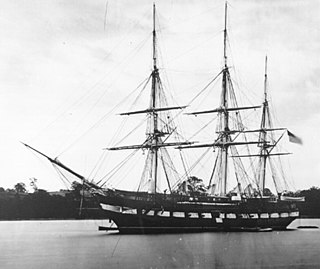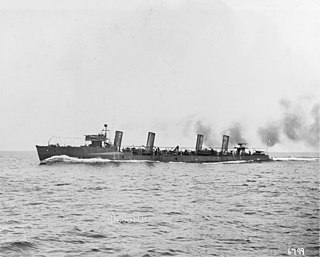Five ships of the United States Navy have been named Decatur, in honor of Commodore Stephen Decatur.

The United States Navy (USN) is the naval warfare service branch of the United States Armed Forces and one of the seven uniformed services of the United States. It is the largest and most capable navy in the world and it has been estimated that in terms of tonnage of its active battle fleet alone, it is larger than the next 13 navies combined, which includes 11 U.S. allies or partner nations. with the highest combined battle fleet tonnage and the world's largest aircraft carrier fleet, with eleven in service, and two new carriers under construction. With 319,421 personnel on active duty and 99,616 in the Ready Reserve, the Navy is the third largest of the service branches. It has 282 deployable combat vessels and more than 3,700 operational aircraft as of March 2018, making it the second largest and second most powerful air force in the world.

Stephen Decatur Jr. was a United States naval officer and commodore. He was born on the eastern shore of Maryland in Worcester County, the son of a U.S. naval officer who served during the American Revolution. His father, Stephen Decatur Sr., was a commodore in the U.S. Navy, and brought the younger Stephen into the world of ships and sailing early on. Shortly after attending college, Decatur followed in his father's footsteps and joined the U.S. Navy at the age of nineteen as a midshipman.
- USS Decatur (1839), was a sloop-of-war built in 1839 and in service from 1840 to 1859.
- USS Decatur (DD-5), was a Bainbridge-class destroyer which served mainly in or near the Philippines from 1902 to 1919.
- USS Decatur (DD-341), was a Clemson-class destroyer which served from 1922 to 1945.
- USS Decatur (DDG-31), was a Forrest Sherman-class destroyer in service from 1956 to 1983, later converted to become the first Self Defense Test Ship.
- USS Decatur (DDG-73), is an Arleigh Burke-class destroyer commissioned in 1998 and currently in active service.

USS Decatur was a sloop-of-war in the United States Navy during the mid-19th century. She was commissioned to protect American interests in the South Atlantic Ocean, including the interception of ships involved in the African slave trade. Decatur served in both the Mexican–American War and the American Civil War.

In the 18th century and most of the 19th, a sloop-of-war in the Royal Navy was a warship with a single gun deck that carried up to eighteen guns. The rating system covered all vessels with 20 guns and above; thus, the term sloop-of-war encompassed all the unrated combat vessels, including the very small gun-brigs and cutters. In technical terms, even the more specialised bomb vessels and fireships were classed as sloops-of-war, and in practice these were employed in the sloop role when not carrying out their specialized functions.

The second USS Decatur (DD-5) was a Bainbridge-class destroyer in the United States Navy. She was named in honor of Stephen Decatur.
| This article includes a list of ships with the same or similar names. If an internal link for a specific ship led you here, you may wish to change the link to point directly to the intended ship article, if one exists. |








